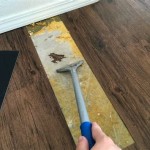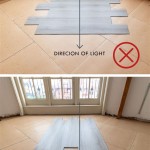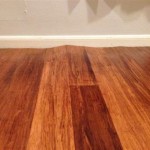Light Rustic Oak Laminate Flooring: A Comprehensive Overview
Light rustic oak laminate flooring represents a popular choice for homeowners and businesses seeking a blend of aesthetic appeal, durability, and cost-effectiveness. This flooring option effectively mimics the natural beauty of oak wood, characterized by its light color palette and rustic textures, while offering the practical advantages associated with laminate construction. Understanding the nuances of light rustic oak laminate flooring, from its composition and installation to its maintenance and suitability for various spaces, is crucial for making an informed decision about incorporating it into a building project.
Laminate flooring, in general, is a multi-layered synthetic flooring product fused together through a lamination process. It typically comprises four distinct layers: a wear layer, a decorative layer, a core layer, and a backing layer. The wear layer, usually made of a transparent melamine resin, provides resistance against scratches, stains, and fading. The decorative layer is a high-resolution photographic image that replicates the appearance of natural wood, in this case, light rustic oak. The core layer, commonly constructed from high-density fiberboard (HDF) or medium-density fiberboard (MDF), contributes to the flooring's structural stability and impact resistance. Finally, the backing layer, often composed of melamine or another moisture-resistant material, enhances the flooring's dimensional stability and prevents moisture from penetrating the core.
The specific characteristics of light rustic oak laminate flooring derive from the decorative layer. This layer accurately reproduces the grain patterns, knots, and color variations found in natural light-toned oak wood. The rustic element is achieved through the inclusion of realistic textures and imperfections that mimic the aged and weathered appearance of real oak. This can involve embossed textures that follow the wood grain, creating a tactile and visually compelling surface. The light color palette typically incorporates shades of beige, cream, and light brown, offering a bright and airy aesthetic that complements a wide range of interior design styles.
Key Considerations Before Installation
Prior to installing light rustic oak laminate flooring, several crucial factors must be considered to ensure a successful and long-lasting result. Proper subfloor preparation is paramount. The subfloor, which is the underlying structural layer onto which the laminate is installed, needs to be clean, level, and dry. Any imperfections, such as cracks, bumps, or unevenness, should be addressed before proceeding. Cleaning the subfloor involves removing any debris, dust, or residue that could interfere with the adhesion of the underlayment or the proper locking of the laminate planks.
Leveling the subfloor is essential to prevent unevenness and potential damage to the laminate flooring. This can be achieved through the use of self-leveling compounds or by sanding down high spots. Ensuring that the subfloor is within the manufacturer's recommended tolerance for flatness is critical for preventing issues such as creaking, flexing, or joint separation. A moisture test should also be conducted to determine the moisture content of the subfloor. Excessive moisture can lead to warping, swelling, or mold growth in the laminate flooring. If the moisture content is too high, a moisture barrier or vapor retarder should be installed before laying the underlayment.
The choice of underlayment is another important consideration. Underlayment is a thin layer of material that is installed between the subfloor and the laminate flooring. It provides several benefits, including sound absorption, thermal insulation, and added cushioning. The type of underlayment that is best suited for a particular installation will depend on the specific needs of the space, such as the level of foot traffic, the presence of radiant heat, and the desired level of noise reduction. Some underlayments also offer additional moisture protection.
Acclimation of the laminate flooring is a crucial step that is often overlooked. Laminate flooring is susceptible to expansion and contraction due to changes in temperature and humidity. To minimize these effects, the laminate planks should be allowed to acclimate to the room's environment for at least 48 to 72 hours before installation. This involves unboxing the planks and spreading them out throughout the room, allowing them to adjust to the ambient temperature and humidity levels. Skipping this step can result in gaps between the planks or buckling of the flooring after installation.
Advantages of Light Rustic Oak Laminate Flooring
Light rustic oak laminate flooring offers a number of distinct advantages that contribute to its popularity. Cost-effectiveness is a significant factor. Compared to solid hardwood flooring, laminate is considerably less expensive to purchase and install. The lower material cost, combined with the relatively straightforward installation process, makes laminate an attractive option for budget-conscious homeowners. This allows for achieving the desired aesthetic of natural oak without incurring the high cost associated with real wood.
Durability is another key benefit. The wear layer of laminate flooring provides excellent resistance against scratches, scuffs, and stains. This makes it a practical choice for high-traffic areas, homes with pets, and families with children. The robust construction of laminate flooring can withstand the daily wear and tear of a busy household, maintaining its appearance for many years. The resistance to staining also simplifies cleaning and maintenance, requiring only regular sweeping or vacuuming and occasional damp mopping.
Ease of installation is a major advantage for DIY enthusiasts. Laminate flooring typically features a click-lock installation system, which allows for planks to be easily connected without the need for nails or glue. This simplifies the installation process and reduces the time and effort required to complete the project. While professional installation is always an option, many homeowners choose to install laminate flooring themselves to save on labor costs. The click-lock system also allows for easy removal and replacement of individual planks if necessary.
Low maintenance requirements are a significant selling point. Unlike hardwood flooring, laminate does not require regular sanding, sealing, or waxing. Routine cleaning consists of sweeping or vacuuming to remove dirt and debris, followed by damp mopping with a mild detergent. Avoid using excessive water, as this can seep into the seams and damage the core layer. Spills should be cleaned up promptly to prevent staining. The low maintenance nature of laminate flooring makes it an ideal choice for busy individuals and families who want a beautiful and durable floor without the hassle of extensive upkeep.
Versatility in design is another appealing aspect. Light rustic oak laminate flooring complements a wide range of interior design styles, from traditional to contemporary. The light color palette and rustic textures create a warm and inviting atmosphere, while the realistic wood grain patterns add visual interest. Laminate flooring is available in a variety of plank sizes and thicknesses, allowing for customization to suit individual preferences and room dimensions. It can also be used in various rooms throughout the house, including living rooms, bedrooms, kitchens, and hallways.
Suitable Applications and Limitations
Light rustic oak laminate flooring is suitable for a variety of applications, but it also has certain limitations that should be considered. In residential settings, it is commonly used in living rooms, dining rooms, bedrooms, hallways, and kitchens. Its durability and water resistance make it a practical choice for areas that are prone to spills and foot traffic. However, it is generally not recommended for bathrooms or laundry rooms, where high levels of moisture can potentially damage the core layer. While some laminate flooring products are specifically designed for wet areas and may offer enhanced water resistance, it is important to carefully consider the manufacturer's recommendations before installing them in such environments.
In commercial settings, light rustic oak laminate flooring can be used in offices, retail stores, and other low-to-medium-traffic areas. Its durability and ease of maintenance make it a practical choice for businesses that want a stylish and cost-effective flooring solution. However, it is generally not recommended for high-traffic areas, such as shopping malls or airports, where heavy use can eventually lead to wear and tear. For these types of applications, more durable flooring options, such as commercial-grade vinyl or engineered hardwood, may be more suitable.
One limitation of laminate flooring is that it cannot be refinished like solid hardwood. If the wear layer becomes damaged, the only option is to replace the affected planks. However, the durability of laminate flooring means that it can often last for many years with proper care and maintenance, making replacement unnecessary. Another limitation is that laminate flooring can sometimes feel less warm and comfortable underfoot compared to solid hardwood. This can be mitigated by installing a thicker underlayment or by using area rugs to add warmth and cushioning.
In terms of aesthetic limitations, while laminate flooring effectively mimics the appearance of natural wood, it does not possess the same unique characteristics and variations that are found in real wood. Some people may prefer the authentic look and feel of solid hardwood, with its natural grain patterns and imperfections. However, advancements in laminate flooring technology have resulted in increasingly realistic and visually appealing products that can closely resemble the look of natural wood.
Overall, light rustic oak laminate flooring offers a compelling combination of aesthetic appeal, durability, cost-effectiveness, and ease of maintenance. Its versatility and wide range of applications make it a popular choice for homeowners and businesses alike. By carefully considering the factors discussed in this article, individuals can make an informed decision about whether light rustic oak laminate flooring is the right choice for their specific needs and preferences. Choosing the correct underlayment, properly preparing your subfloor, and allowing for acclimation are vital for longevity.

Light Rustic Oak Laminate Flooring Planks By Quick Step Largo

Quickstep Rustic White Oak Light Laminate Flooring 8 Mm Ric1497 Laminates

Quick Step Largo Light Rustic Oak Planks Lpu1396 Laminate Flooring

Quick Step Largo Light Rustic Oak Planks Lpu1396 Laminate Flooring

Quick Step Largo Light Vintage Oak Planks Laminate Flooring

Elka 8mm Laminate Rustic Oak Flooring

Quick Step Largo Light Vintage Oak Planks Laminate Flooring

Rustic Oak Light Grey Id Ultimate 55 70 Modular Vinyl

Lightly Brushed Light Natural Uv Oiled Rustic Oak Flooring

8mm Groove Rustic Oak Laminate Flooring Elka
Related Posts








